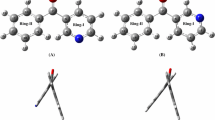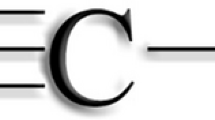Abstract
The IR-spectra of 4-aminopyridine (4-AP) in solution and in the solid state have been analyzed, using the reducing-difference procedure. Defining a more precise band assignment of a part of the characteristic frequencies of 4-AP, the data obtained proved in particular a Fermi-resonance splitting of the symmetric NH2-stretch.
Similar content being viewed by others
References
A. Loboda and C.M. Armstrong: “Resolving the Gating Charge Movement Associated with Late Transitions in K Channel Activation”, Biophys. Journal, Vol. 81, (2001), pp. 905–916.
C. Hayes, K.C. Katz, M.A. Devane, J.G. Hsieh, J.T.C., Wolfe, D.L. Potter and P.J.A.R. Blight: “Pharmacokinetics of an Immediate-Release Oral Formulation of Fampridine (4-Aminopyridine) in normal Subjects and Patients with Spinal Cord Injury”, J. Clin. Pharmacol., Vol. 43, (2003), pp. 379–385.
R. Ballardini, M.T. Gandolfi, V. Balzani, F.H. Kohnke and J.F. Stoddart: “Second-Sphere Photochemistry and Photophysics: Luminescence of the [Pt(bpy)(NH3)2]2 ⊕-Dibenzo[30]crown-10 Adduct”, Angew. Chem., Int. Ed. Engl., Vol. 27, (1988), pp. 692–701.
Z. Dega-Szafran, A. Kania, B. Nowak-Widra and M. Szafran: “UV, 1H and 13C NMR spectra, and AM1 studies of protonation of aminopyridines”, J. Mol. Struct., Vol. 322, (1994), pp. 223–232.
T.J. Prior and M.J. Rosseinsky: “Crystal engineering of a 3-D coordination polymer from 2-D building blocks”, Chem. Commun., (2001), pp. 495–497.
E. Spiner: “The vibrational spectra and structures of the hydrochlorides of aminopyridines”, j. Chem. Soc., (1962), pp. 3119–3125.
B.D. Batts and E. Spiner: “Vibration spectral and structural comparison of the 4-aminopuridine cation with the 4-hydroxypiridinium N- and C-deuterated, and N-methylated ions. Relevant NMR. spectral studies”, Aust. J. Chem., Vol. 22, (1969), pp. 2595–2610.
M.G. Arnaudov, B.B. Ivanova and Sh. Dinkov: “A linear dichroic infrared (IRLD) solid state spectral study of 4-aminopyridine”, Vibrational Spectroscopy, (2004), submitted.
B. Jordanov, R. Nentchovska and B. Schrader: “FT-IR linear dichroic solute spectra of nematic solutions as a tool for IR band assignment”, J. Mol. Struct., Vol. 297, (1993), pp. 401–406.
B. Jordanov and B. Schrader: “Reduced IR-LD spectra of substances oriented as nematic solutions”, J. Mol. Struct., Vol. 347, (1995), pp. 389–398.
M.G. Arnaudov: “The influence of the medium on the infrared spectrum of self-associated systems”, Intern. J. Vibr. Spectrosc., Vol. 5, (2001), pp. 1–18.
M.G. Arnaudov and Sh. Dinkov: “IR-LD-spectral study on the self-association effects of 2-aminopyridine”, J. Mol. Struct., Vol. 476, (1999), pp. 235–241.
M.G. Arnaudov and Y. Dimitriev: “Study on the structural transition in binary tellurite glasses by means of reduced infrared spectra”, Phys. Chem. Glasses, Vol. 42, (2001), pp. 99–102.
C.L. Angyal and R.L. Werner: “The tautomerism of N-heteroaromatic Amines. Part II. Infrared spectroscopic evidence”, J. Chem. Soc., (1952), pp. 2911–2915.
J.D.S. Goulden: “The structure of the aminopyridines”, J. Chem. Soc., (1952), pp. 2939–2940.
S.F. Maeson: “The frequencies and intensities of the NH stretching vibrations in primary amines”, J. Chem. Soc., (1958), pp. 3619–2627.
K.V. Ramiah and P.G. Puranik: “Infrared Spectroscopic Studies of Association of amino-pyridines”, J. Mol. Spectrosc., Vol. 7, (1961), pp. 89–104.
W.K. Thompson: “Infrared absorbtion spectra of Dimethyl sulphoxide solutions. Part I. Heterocyclic amines”, J. Chem. Soc., (1962), pp. 617–621.
S. Akyuz: “The FT-IR spectroscopic investigation of transition metal(II) 4-aminopyridine tetracyanonickelate complexes”, J. Mol. Struct., Vol. 482, (1999), pp. 171–174.
Y. Buyukmurat and S. Akyuz: “Theoretical and experimental studies of IR spectra of 4-aminopyridine metal(II) complexes”, J. Mol. Struct., Vol. 651, (2003), pp. 533–539.
H. Wolff and D. Staschewski: “Raman spectroskopishe Utersuchungen die fluessingen primaeren aliphatishen Aminen. 2. Mitteilung. Eingehendere Deutung der an den NH-Valenzbanden gewonnen Ergebnisse”, Ber. Bunsenges. Phys. Chem., Vol. 66, (1962), pp. 140–155.
J. Lauransan, P. Pineau and M.-T. Josier: “Etude par spectroscopie infrarouge des association moleculaires entre la parabromoaniline et divers solvents”, Ann. Chim., Vol. 9, (1964), pp. 213–227.
J. Lauransan, J. Corset and M.-T. Forel: “Application du calcul de vibration a l'etude par spectrometrie infrarouge des complexes formee par liason hydrogene entre les groupements XH2 on XH3 et divers acceptenrs de proton”, Ann. Chim., Vol. 3, (1968), pp. 109–119.
H. Wolff and D. Horn: “Ueber die Fermi-Resonanz bei der Wasserstoffbrueckenassonziation primaerer aliphatisher Amine”, Ber. Bunsenges. Phys. Chem., Vol. 72, (1968), pp. 419–429.
H. Wolff and D. Horn: “Ultrarotspektroskopishe Untersuchungen der Wasserstoffbrueckenassoziation von 2,2,2-Trifluoraethylamin. 1. Mitteilung. Die Messesgebnisse und ihre elementare Deutung”, Ber. Bunsenges. Phys. Chem., Vol. 71, (1967), pp. 467–478.
H. Wolff and D. Mathias: “Hydrogen bonding and Fermi-resonance of aniline”, J. Phys. Chem., Vol. 77, (1973), pp. 2081–2084.
M.G. Arnaudov and Sh. Dinkov: “IR-spectral study of self-association effects of 2-aminopyridine in solution”, Spectroscopy Letters., Vol. 31, (1998), pp. 1687–1703.
M. Chao and E. Schempp: “An X-ray and NQR study of 4-aminopyridine and related aromatic amines”, Acta. Crystall., Vol. B33, (1977), pp. 1557–1564.
H. Wolff and J. Eints: “Ultrarotutersuchungen der Assoziation von primaeren mit tertiaeren aliphatishen Amines”, Ber. Bunsenges. Phys. Chem., Vol. 70, (1966), pp. 728–733.
V.E. Borisenko, A.V. Moreva, I. Faizullina and A. Koll: “Dynamic, electrooptical and energetic nonequivalency of NH bonds in 1∶1 and 1∶2 complexes of aminopyridines with proton acceptors”, J. Mol. Struct. Vol. 560, (2001), pp. 121–136.
J. Smets, L. Adomowicz and G. Maes: “Matrix-Isolation FT-IR Studies and Ab-Initio Calculations of Hydrogen-Bonded Complexes of Molecules Modeling Cytosine or Isocytosine Tautomers. 2. 4-Aminopyridine and 4-Aminopyrimidine Complexes with H2O in Ar Matrixes”, J. Phys. Chem., Vol. 99, (1995), pp. 6387–6400.
G. Keresztury, F. Billes, M. Kubinyi and T. Sundius: “A Density Functional, Infrared Linear Dichroism, and Normal Coordinate Study of Phenol and its Deuterated Derivatives: Revised Interpretation of the Vibrational Spectra”, J. Phys. Chem., Vol. 102A, (1998), pp. 1371–1380.
Author information
Authors and Affiliations
About this article
Cite this article
Arnaudov, M.G., Ivanova, B.B. & Dinkov, S.G. A reducing-difference IR-spectral study of 4-aminopyridine. cent.eur.j.chem. 2, 589–597 (2004). https://doi.org/10.2478/BF02482723
Received:
Accepted:
Issue Date:
DOI: https://doi.org/10.2478/BF02482723




